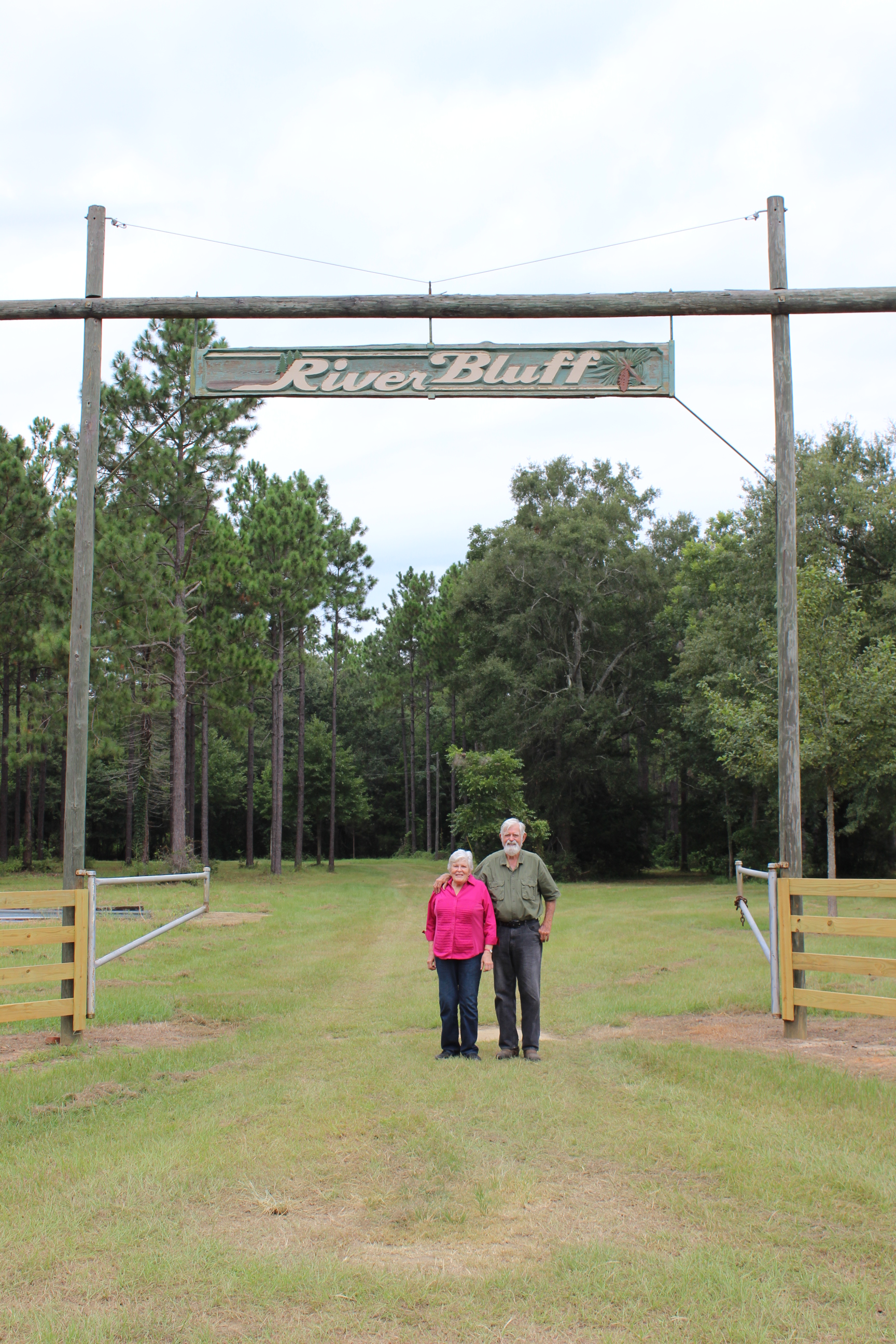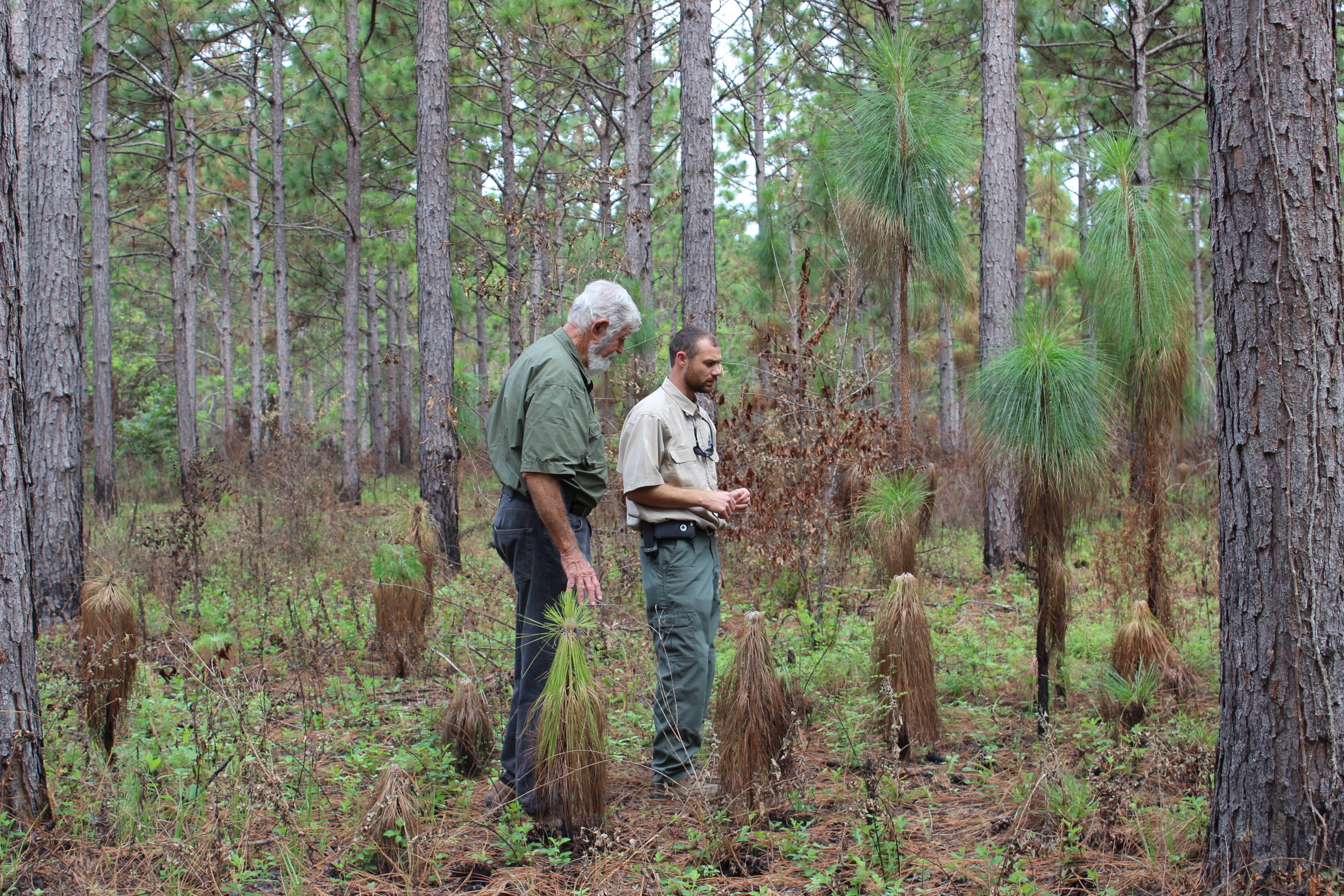South Nominee: James Todd from Alabama
What makes them outstanding?
The 2017 Alabama Tree Farmer of the Year Dr. and Mrs. James Todd show excellence in forest management and sustainable forestry practices. Tree Farm certification is based on Wood, Water, Wildlife, and Recreation, and the Todd’s River Bluff Farm excels in all areas. Their efforts in Education and Outreach are also highly commendable, and include hosting students and fellow landowners on their property.
Dr. and Mrs. Todd do much of the work on the property themselves. Because they live and work on their Tree Farm, they are aware of many changes in the landscape that for so many landowners might go un-noticed. A fallen tree, a new patch of invasives, like cogon grass or sweet gums, a patch of fresh dirt by their pond, or a gopher tortoise burrow, are all noticed and when needed, steps are taken to continue the intensive management of their forest. Dr. & Mrs. Todd have also recognized the benefits of prescribed fire, and it is a tool that is utilized yearly on their property. They are hands on landowners, working to build a legacy of forest stewardship for their children and grandchildren.
Tree Farmer story
 Located in Geneva County is
the property of Dr. and Mrs. Todd, Alabama’s 2017 Tree Farm of the Year. The
400-acre certified Tree Farm is situated in the High Bluff community and sits
on what is arguably the highest bluff along the Choctawhatchee River. They
purchased the property from Mrs. Todd’s father several years ago. When they
purchased the property, there were very few trees on the property. It was
comprised mostly of pastureland and row crops, such as Cotton, peanuts, and
soybeans. Soon after the purchase they enrolled the property into the
Conservation Reserve Program (CRP) and planted Longleaf pine, Slash pine, and
Loblolly pine. They didn’t fathom at
that time what the young forest would turn into years later. As their forest
began to grow and mature, so did the Todd’s interest and knowledge for natural
resource management. They began attending landowner tours and educational
events that taught sound forest management. They took the information that they
learned and began practicing and implementing them on their property. Soon
thereafter, the Todds began to realize that there were several other landowners
in their community that had the same interest in forest management but lacked
the skill and knowledge, just as they did just a few years prior. They began
working with several natural resource agencies and organizations to host
landowner tours. The topics on these tours covered vital management techniques
such as prescribed burning, water quality, Alabama’s Best Management Practices
(BMPs), and invasive species control. The partnership between the Todds and
these natural resource agencies and organizations has allowed these agencies to
bring landowners with questions to the Todd’s property. This one on one time is
spent answering specific questions and teaching proper management techniques.
There are several unique features on the Todds property. The sign that is
displayed at the property entrance gate is made from an old growth Longleaf
slat that Dr. Todd hand carved himself.
He made columns on the front porch of his farm office from a piece of
lightered that he found while on a quail hunt in South Georgia. Another unique
feature is the floor in his house. When the Todds lived in Georgia, their
neighbor had several Sycamore trees in their back yard. When the neighbor got
ready to cut them down, Dr. Todd asked if he could have them. He took them to a
local sawmill and had them cut up into hardwood flooring, which is now in
several rooms in his house.
Located in Geneva County is
the property of Dr. and Mrs. Todd, Alabama’s 2017 Tree Farm of the Year. The
400-acre certified Tree Farm is situated in the High Bluff community and sits
on what is arguably the highest bluff along the Choctawhatchee River. They
purchased the property from Mrs. Todd’s father several years ago. When they
purchased the property, there were very few trees on the property. It was
comprised mostly of pastureland and row crops, such as Cotton, peanuts, and
soybeans. Soon after the purchase they enrolled the property into the
Conservation Reserve Program (CRP) and planted Longleaf pine, Slash pine, and
Loblolly pine. They didn’t fathom at
that time what the young forest would turn into years later. As their forest
began to grow and mature, so did the Todd’s interest and knowledge for natural
resource management. They began attending landowner tours and educational
events that taught sound forest management. They took the information that they
learned and began practicing and implementing them on their property. Soon
thereafter, the Todds began to realize that there were several other landowners
in their community that had the same interest in forest management but lacked
the skill and knowledge, just as they did just a few years prior. They began
working with several natural resource agencies and organizations to host
landowner tours. The topics on these tours covered vital management techniques
such as prescribed burning, water quality, Alabama’s Best Management Practices
(BMPs), and invasive species control. The partnership between the Todds and
these natural resource agencies and organizations has allowed these agencies to
bring landowners with questions to the Todd’s property. This one on one time is
spent answering specific questions and teaching proper management techniques.
There are several unique features on the Todds property. The sign that is
displayed at the property entrance gate is made from an old growth Longleaf
slat that Dr. Todd hand carved himself.
He made columns on the front porch of his farm office from a piece of
lightered that he found while on a quail hunt in South Georgia. Another unique
feature is the floor in his house. When the Todds lived in Georgia, their
neighbor had several Sycamore trees in their back yard. When the neighbor got
ready to cut them down, Dr. Todd asked if he could have them. He took them to a
local sawmill and had them cut up into hardwood flooring, which is now in
several rooms in his house.
For the following areas describe how the landowner's management addresses it
Wood: The property is diversified with several different species of both pine and hardwood. To achieve his primary objective of timber management he uses many techniques such as prescribed burning, timely thinning, mowing, and chemical treatment of invasives. Dr. Todd knew that it was extremely important to plant the best genetics he could to increase wood quality and production. All of his Slash pine and Loblolly pine stand are genetically improved. Dr. Todd maintains firebreaks annually to protect his forest from wildfire. Perhaps the most interesting thing about the Todds is their joint effort to mark each stand of timber together before they are harvested. It is rare to find both husband and wife covered in blue marking paint! Pulpwood, cantor wood, sawtimber have been harvested harvested from the property to date, with poles becoming a realist possibility in the future. Dr. Todd uses natural uneven aged management to achieve an aesthetically pleasing Longleaf stand that is situated in front of his house. One example of his management in this stand is conducting a prescribed fire during the month of August. Doing this prepared the seed bed and allowed the seed to reach the mineral soil and germinate.
Water: Streamside Management
Zones (SMZs) are prevalent throughout the property and are carefully managed to
prevent damage to water quality. These SMZs are extremely important where the
property meets the river because of the steep bluff that would sub come to
erosion easily. The Todd’s also follow Alabama’s Best Management Practices
(BMPs) when any activities such as timber harvesting takes place. Several
springs flow to fill his pond, which was the first Green Tree Reservoir in the
state of Alabama. To control erosion on his pond dam, Dr. Todd has planted a
variety of peanut, that he developed, to stabilize the soil. Water control
devises such as water bars and turnouts are on all roads and firebreaks to prevent
erosion and soil stability.
harvesting takes place. Several
springs flow to fill his pond, which was the first Green Tree Reservoir in the
state of Alabama. To control erosion on his pond dam, Dr. Todd has planted a
variety of peanut, that he developed, to stabilize the soil. Water control
devises such as water bars and turnouts are on all roads and firebreaks to prevent
erosion and soil stability.
Wildlife including threatened and endangered species: Not only is forest management a major emphasis for the Todds, but wildlife management is equally important. They were awarded the Region and State Wildlife Conservationist of the Year by the Natural Resource Conservation Service in 2015. In addition to sowing summer and winter food sources for game species, the Todd’s also mark Gopher Tortoise burrows with pin flags as to not disturb the apron when any activity is taking place in the area. This is extremely important because the Gopher Tortoise has been requested to be listed as threatened by the U.S. Fish and Wildlife Service. Prescribed fire is used annually to help promote native grasses for browse of several game and non-game species including the Gopher Tortoise. He has planted hard and soft mast producing trees specifically for wildlife. While most of his wildlife management is done to increase wildlife habitat and populations, he does do some management to reduce certain populations. Dr. Todd actively traps beavers that become a nuisance by chewing on trees around the pond and causing erosion problems on the dam.
Recreation and Aesthetics including special sites: One of the great benefits of managing their property is great recreation. Several activities are enjoyed on the property such as deer and quail hunting, fishing, hiking, bird watching, and trapping.


